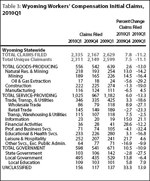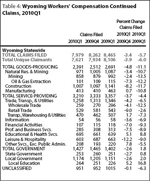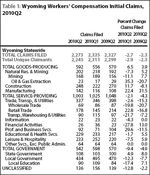Workplace Safety: Analysis Using Workers' Compensation Data in Wyoming
Workers' Compensation (WC) records represent some of the most comprehensive information about workplace injures and illnesses in Wyoming. These records can be used to analyze the circumstances surrounding injuries, provide prevention guidance, and prepare first responders. This article introduces the reader to the incidence of claims information by type of claim and the industry of occurrence in Wyoming.
Previous research using the WC dataset has yielded useful conclusions. For example, Leonard found that "injuries occurring in winter, spring  and summer led to greater wage loss than those occurring in the fall" (Leonard, 2009). A tabular analysis of workplace safety for nurses in Wyomingused WC data to indicate the rate at which nurses filed claims (see http://doe.state.wy.us/
and summer led to greater wage loss than those occurring in the fall" (Leonard, 2009). A tabular analysis of workplace safety for nurses in Wyomingused WC data to indicate the rate at which nurses filed claims (see http://doe.state.wy.us/
LMI/dashboard/toc.htm). Further research using the datasets could yield beneficial insight into the effects of workplace injury on the dynamics of Wyoming's economy.
All claims from the Wyoming WC database with a status other than denied, duplicate, or potential duplicate are included in the tabulations in this article.
For a given quarter, an initial claim is defined as a claim where the date of injury occurred in that quarter. A continued claim is defined as one that was initiated prior to the reference quarter and is still an active claim. Continued claims may cover long periods of time. Therefore, changes in the number of continued claims are likely to be less volatile than changes in the number of initial claims.
Figure 1 demonstrates the change in both initial and continued claims from fourth quarter 2007 through third  quarter 2010. The drop in initial claims
quarter 2010. The drop in initial claims  starting in third quarter 2008 through second quarter 2009 may be correlated with a drop in overall employment levels in Wyoming.
starting in third quarter 2008 through second quarter 2009 may be correlated with a drop in overall employment levels in Wyoming.
Each of the four tables shown has a reference quarter, the quarter previous to the reference quarter, and the quarter one year previous to reference quarter. This allows a comparison of the changes in the number of claims over a short period. Each table includes both the count of claims and claimants. Tables 1 and 3 describe initial claims, while Tables 2 and 4 portray continued claims. For the most recent quarter available (second quarter 2010; Table 1), there were 2,245 people filing 2,273 claims. This represents a 2.7% and 2.3% decrease in claims from the previous quarter and the previous year, respectively. By comparison, the number of initial claims in first quarter 2010 increased 7.8% from the previous quarter and decreased 11.2% from the previous year (see Table 3). For continued claims (Tables 2 and 4), the change in number of claims was less volatile, as expected. For example, during second quarter 2010, the number of continued claims increased 1.1% from the previous quarter and decreased 3.0% from the prior year (see Table 2).
Workplace safety is important for many reasons, including the stability of the nation's health, social, and economic institutions. Wyoming's Workers' Compensation database is one of the most complete of any state in the country. Wyoming is one of only four states that have exclusive Workers' Compensation state insurance programs. North Dakota, Ohio, and Washington are the others (National Academy of Sciences).
Further research using these data could potentially yield substantial benefits without incurring additional data collection costs (Utterback and Schnorr, 2010).
References
Leonard, D. The NEW Report: Nurse Employment in Wyoming (NEW), Second Quarter 2006 Through Second Quarter 2008. Retrieved November 3, 2010, from http://doe.state.wy.us/LMI/dashboard/08Q2tab1.htm
Leonard, D. Post Injury Wage-Loss: A Quasi-Experimental Design. (2009). Retrieved November 3, 2010, from http://doe.state.wy.us/LMI/post_injury/default.htm
National Academy of Social Science. Workers' Compensation: Benefits, Coverage, and Costs, 2007. (2009.) Retrieved November 3, 2010, from http://www.nasi.org/research/2009/report-workers-compensation-benefits-coverage-costs-2007
Utterback, D. 2010. Introduction. In Utterback, D. and Schnorr, T. (Eds.) Use of Workers' Compensation Data for Occupational Injury & Illness Prevention. Proceedings from September 2009 Workshop. Retrieved November 3, 2010, from http://www.cdc.gov/niosh/docs/2010-152/pdfs/2010-152.pdf

